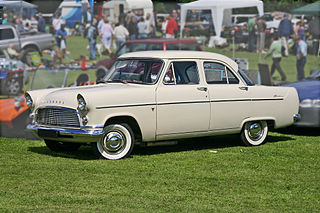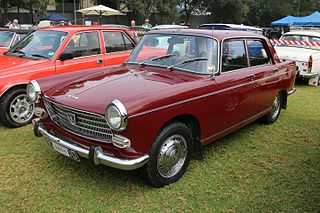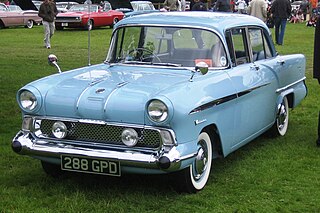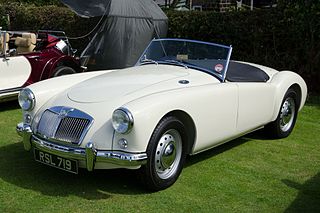
Jowett was a manufacturer of light cars and light commercial vehicles in Bradford, West Riding of Yorkshire, England from 1906 to 1954.

The Ford Popular, often called the Ford Pop, is a car from Ford UK that was built in England between 1953 and 1962. When launched, it was Britain's lowest priced car.

The Ford Zephyr is an executive car manufactured by Ford of Britain from 1950 until 1972. The Zephyr and its luxury variants, the Ford Zodiac and Ford Executive, were the largest passenger cars in the British Ford range from 1950 until their replacement by the Consul and Granada models in 1972.

The Ford Consul is a car that was manufactured by Ford of Britain from 1951 until 1962. The name was later revived for a model produced by Ford in both the UK and in Germany from 1972 until 1975.

The Peugeot 404 is a large family car produced by French automobile manufacturer Peugeot from 1960 to 1975. A truck body style variant was marketed until 1988. Styled by Pininfarina, the 404 was offered initially as a saloon, estate, and pickup. A convertible was added in 1962, and a coupé in 1963. The 404 was fitted with a 1.6 litre petrol engine, with either a Solex carburetor or Kugelfischer mechanical fuel injection or a 1.9 litre diesel engine available as options. Introduced at the Paris Motor Show as an option was the inclusion of a 3-speed ZF automatic transmission, similar to the unit already offered on certain BMW models, as an alternative to the standard column-mounted manual unit.

The Morgan 4/4 is a British motor car which was produced by the Morgan Motor Company from 1936 to 2018. It was Morgan's first car with four wheels, the name indicating that the model has four wheels and four cylinders. Early publicity and advertising material variously referred to the model as "4/4", "4-4", "Four Four", and similar names, but from the outset the factory designation was always "4/4".

The Vauxhall Victor is a large family car produced by Vauxhall from 1957 until 1976. The Victor was introduced to replace the outgoing Wyvern model. It was renamed Vauxhall VX Series in 1976 and continued in production until 1978, by which time it had grown significantly and was viewed, at least in its home market, as a larger-than-average family car.

The MGA is a sports car that was produced by MG from 1955 until 1962.

The MG T-Type is a series of body-on-frame open two-seater sports cars that were produced by MG from 1936 to 1955. Known as the Midget, the series, included the TA, TB, TC, TD, and TF models. Although the design was contemporary in the 1930s, it had grown outdated by the 1950s, and was replaced by the all new MGA in 1955.

The MG Magnette is a car that was produced by MG between 1953 and 1968. The Magnette was manufactured in two build series, the ZA and ZB of 1953 through to 1958 and the Mark III and Mark IV of 1959 through to 1968, both using a modified Wolseley body and an Austin engine.

The Vauxhall Cresta is a British automobile which was produced by Vauxhall from 1954 to 1972. The Cresta was introduced in 1954 as an upmarket version of the Vauxhall Velox, itself a six-cylinder version of the Vauxhall Wyvern. The Cresta models were the E (1954–1957), PA (1957–1962), PB (1962–1965) and PC (1965–1972). The Viscount (1966–1972) was an upmarket Cresta PC.
The Morris Isis name was first briefly used by Morris Motors Limited on a 6-cylinder car made from 1929 until 1931. It was resurrected on a new 6-cylinder midsize car from the British Motor Corporation in the 1950s to replace the Morris Six MS.

The Rover P4 series is a group of mid-size luxury saloon cars produced by the Rover Company from 1949 until 1964. They were designed by Gordon Bashford.
Henry Meadows, usually known simply as Meadows, of Wolverhampton, England, were major suppliers of engines and transmissions to the smaller companies in the British motor industry. Founded in 1920 in Park Lane, Wolverhampton, as a car gearbox maker, they expanded into petrol engines in 1922 and in the 1930s built a large factory in Fallings Park, Wolverhampton.

The Jowett Bradford was a British light van produced from 1946 to 1953 by Jowett Cars Ltd of Idle, near Bradford, England. It was also available as an estate car from 1947 to 1953.

The Jowett Jupiter is a British sports car which was produced by Jowett Cars Ltd of Idle, near Bradford.

The Mitsubishi Colt 800 is the first of a series of passenger cars with a fastback/hatchback design produced by Mitsubishi Motors from November 1965. It was introduced as a two-door fastback sedan, the first such design in the Japanese market. The series was discontinued in 1971, after the introduction of the company's Galant sedan but without a real replacement.

The Vauxhall Velox is a six-cylinder executive car which was produced by Vauxhall from 1948 to 1965. The Velox was a large family car, directly competing in the UK with the contemporary six-cylinder Ford Zephyr, and to a slightly lesser extent, with the A90, A95, and A110 Austin Westminster models.

The Triumph Renown is strictly the name given to the Triumph's large saloon car made from 1949 to 1954 but it is, in reality, part of a three-car series of the 1800, 2000 and Renown models. Together with the Triumph Roadster, they were the first vehicles to carry the Triumph badge following the company's takeover by the Standard Motor Company.

The Daimler Regency series was a luxury car made in Coventry by The Daimler Company Limited between 1951 and 1958. Only an estimated 49 examples of the 3-litre Regency chassis were made because demand for new cars collapsed just weeks after its introduction. Almost three years later in October 1954, a lengthened more powerful Regency Mark II (DF304) was announced but, in turn, after a production run of 345 cars, it was replaced by the very much faster, up-rated One-O-Four (DF310), announced in October 1955.

























